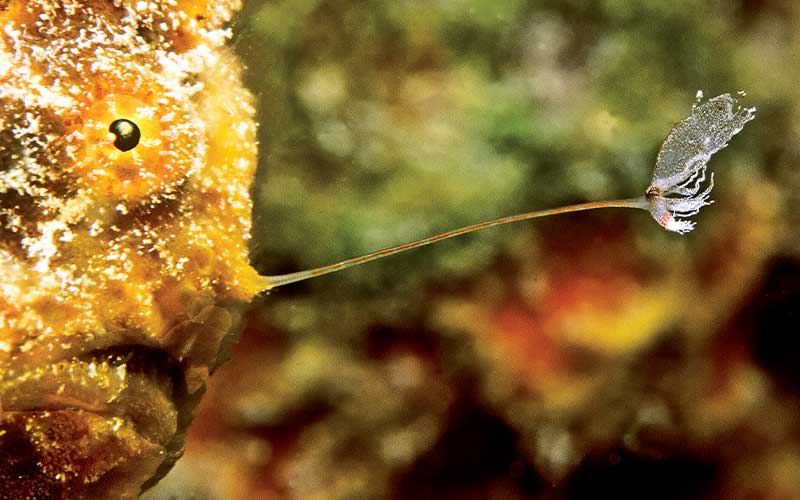On Bonaire, frogfish hold a celebrity status ranking right up there with the hammerheads of Galapagos and the mantas of Yap. The frogfish are such a draw that local naturalists keep close tabs on their whereabouts and generously provide visitors with details. Such details steer us to Bachelor Beach, where a lemon-yellow longlure frogfish the size of a billiard ball has recently taken up residence.
Anna spots our quarry balanced on the lip of a tall vase sponge. It doesn’t take long to understand why the little lie-in-wait predator picked such a precarious perch; a cloud of masked gobies hovers just out of reach. As we move in for a better look, the school becomes distracted and breaks rank. Suddenly riveted with the prospects of an easy meal, the frogfish leans to the limits of gravity, and from the back of its head pivots a tiny rod, tipped with a white tuft, toward the oncoming delicacies. With a well-practiced twitch, the tuft turns into a deadly fish attractor manipulated by a master of deception. At first, a trio of gobies shows some interest but soon flits away. The lure dances again. A second group ventures closer, then a bit closer, then too close. The frogfish lunges, loses its balance and tumbles head over tail, landing awkwardly on its side. Unfazed, it rights itself and half swims, half waddles its improbable bag of a body back up the sponge and retakes the perch. From that moment on, Anna and I become frogfish aficionados of the first order.

The following year finds us in Indonesia’s Lembeh Strait, the frogfish capital of the universe. Our timing couldn’t be better; the strait is full of frogfish, or anglerfish, as the worldwide family of about 50 species (Antennariidae) are known on the other side of the globe. On some dives we locate a half dozen or more, varying in size from juveniles no larger than peanuts to massive specimens with girths rivaling volleyballs.
Noting our interest, our dive guide tells us about a strange lure he once saw shaped like a shrimp with a head, carapace, abdomen, jointed legs and even black dots for eyes. The possibility that frogfish lures might be more than formless bits of tissue had never crossed our minds. This is something we have to investigate.
Although frogfish are built on the basic blueprint of a big stomach with a big mouth, we soon discover there is nothing basic about their fishing gear. The rod, also called the illicium, is actually a highly modified first spine of the dorsal fin that can be rotated freely. When not in use, which is the majority of the time, the rod and lure, or esca, lie back against the body for safekeeping. Most of the lures we examine are indeed small and irregular; however, a few have evolved into jewels of mimicry.
We see some remarkable adaptations, including the beefy, wormlike bait of the striated frogfish and a flowing ribbon lure belonging to a small painted frogfish, but as hard as we search, the fabled shrimp lure remains a fable. Near the end of our stay, the guide swims up displaying the now familiar waggling-finger sign for a frogfish. He leads us to the shallows and points toward a tan frogfish crossing a barren stretch of sand with a determined waddle. Having never seen a lie-in-wait predator on the move, we follow. To everyone’s surprise, the frogfish stops at the edge of a small hole and swings its fishing rod into action just above the entrance. We can’t believe our luck. The bouncing bait looks exactly like a free-swimming shrimp.
With a little after-trip detective work, we find that scientists once believed the crustaceanlike lure was diagnostic of a new species. But after comparisons with preserved specimens, they discovered that more than one Pacific species share the rare trait. Making matters even more confusing, the size and shape of lures within some species vary significantly. As the theory goes, just like a fisherman’s bait is bitten away, frogfish lures also take a beating. Even though the damaged tissue regenerates over a period of months, the elaborate shrimp decoys never regain their original state of perfection.
Back in Bonaire, we continue inspecting frogfish lures out of habit. One morning we encounter a longlure frogfish, the Caribbean’s most common species, sporting a remarkably well-proportioned shrimp lure, the first to be documented on the side of the world where frogfish are known as frogfish.
Explore More
© Alert Diver — Q2 Spring 2011

